Jul 28, 2023
Discover your balance in Shizuoka surf town Makinohara
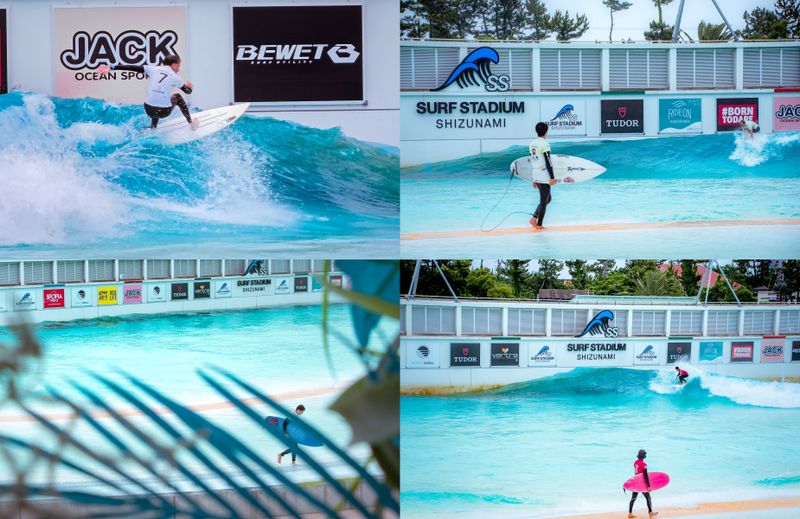
It can be a tricky thing finding balance in life but the city of Makinohara seems to have found a formula that works for many, including a population of surfers and others who have settled nicely into a life by the town’s Pacific Ocean beaches.
The laid-back surf town in central Japan’s Shizuoka Prefecture offers an easy mix of pleasures derived from its proximity to both mountains and sea, and is as welcoming to the visiting surfer and beach lover as it is respectful of the local wave riders. Makinohara is also close enough to urban centers like Tokyo and Nagoya to make a short trip feasible and fun, but far enough away to deter the crowds.
Two full days in town will give the visitor a taste of what it feels like to find balance on the surfboard and perhaps in life, and will likely leave many wishing they could tip the balance of their own lives heavily towards a swift return and a longer stay.
Start with finding balance on a surfboard.
The brilliant white walls and azure waters of wave pool facility Shizunami Surf Stadium bring an upmarket resort feel to the otherwise bohemian and surfy streets of Makinohara’s oceanfront Shizunami district.
Japan’s first large-scale wave pool offers the kind of waveriding technology that rivals wave pools around the world and can accommodate (and has) the would-be waverider with zero experience right through to athletes at the peak of the sport, including former world and current Olympic champions.
Less than a month after the first trial run of the waves at Shizunami Surf Stadium, the facility welcomed athletes from USA’s Olympic surf team who arrived in town to practice ahead of competition at the Tokyo 2020 Summer Games, according to Shizunami Surf Stadium CEO Toshihiko Adachi.
"A week before that, the Japan national team also came here for a training camp. If it had not gone well, I might not be here (today)," Adachi told us with a giggle.
The positive early feedback from some of surfing’s elite must have armed Adachi and his team with the confidence of knowing that their facility could offer something to the most demanding of surfers. The seal of approval did little, however, to assuage the waveriding insecurities held by this visiting surfer ahead of their session at the wave pool.
A first-timer to surfing artificial waves, I had many questions ahead of a one-hour session with nine other surfers (sessions are limited to 10) - How is the line-up organized? Where do I sit in preparation for a wave? How much power can an artificial wave possibly pack?
Many of these questions were addressed during a pre-session briefing and a member of staff was in the water throughout offering advice on positioning and advance notice of an approaching wave. (Compared to surfing in the ocean, waves at Shizunami Surf Stadium don’t so much approach as they do appear rather suddenly.) A few waves into the session and I got a feel for the surprising amount of power that the wave (at this setting) could generate, seeming to build as the wave ran on after a relatively forgiving take off.
Those with even more questions about surfing and its fundamentals can choose a taiken "experience" course for beginners which includes instruction in and out of the water, wetsuit and board rental. The wave at Shizunami Surf Stadium can be customized to fit a range of courses and sessions from the aforementioned taiken course all the way through to something to challenge the experts.
I came away from the session finally rid of some long-held surfing insecurities, giddy with satisfaction, and craving a swift return to the wave knowing that its near perfect form and consistency could deliver not only massive doses of fun but also swift improvement in my surfing.
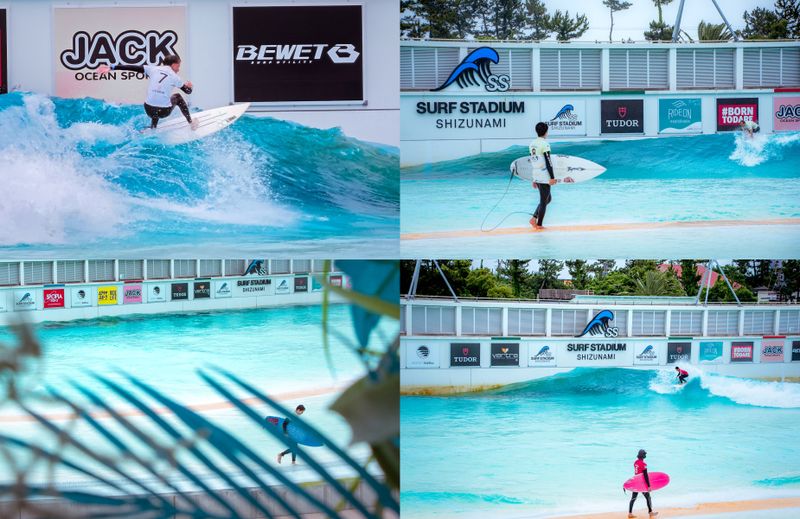
Shizunami Surf Stadium, Makinohara, Shizuoka Pref.
Surfers can bask in their post-session glow at Shizunami Surf Stadium in a poolside jacuzzi or by lounging on a rooftop terrace enjoying views to Mt. Fuji, weather permitting. There are also private poolside relaxation areas available to rent and an onsite surf shop. The poolside facilities can also be enjoyed by those visitors who do not wish to surf.
Shizunami Surf Stadium differs from similar wave pools around the world in its proximity to the ocean and the natural breaks to be found at Shizunami Beach which can be reached within a short stroll of the wave pool.
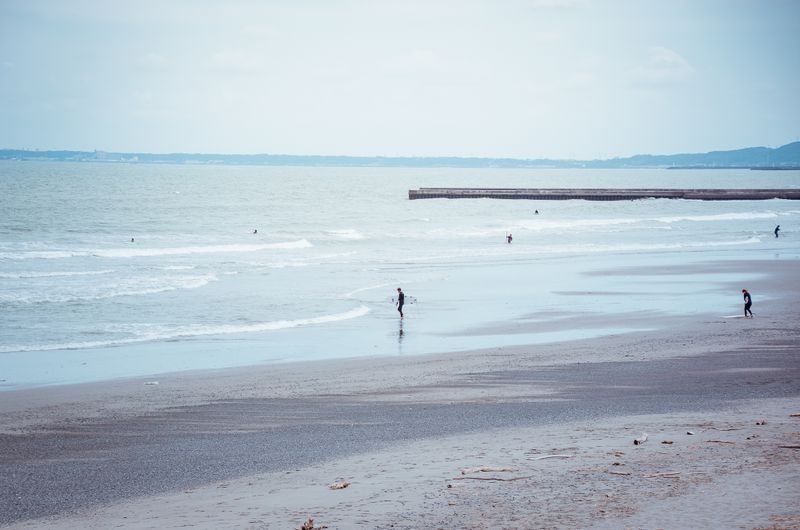
Shizunami Beach, a short walk from the Shizunami Surf Stadium wave pool, Makinohara, Shizuoka Pref.
Where wave pool technology has typically enhanced its reputation for wave-generating reliability by delivering the goods to otherwise wave-starved communities far from the coast, Shizunami Surf Stadium enhances Makinohara as a year-round surf destination even when the ocean isn’t in the mood.
"Recently some of our guests have been coming to Makinohara for a longer stay, staying for two weeks and coming to the wave pool every other day to surf, going out to the ocean on days when the conditions are good, visiting Mt. Fuji, and making Makinohara their base," Adachi said.
"Come to Makinohara, where the climate is good, the food is good, and the surfing is even better!"
Shizunami Surf Stadium is only around two blocks from Shizunami Beach, Makinohara’s most popular stretch of sand where the waves are welcoming of visiting surfers and ocean users. Temporary beach houses and eateries appear in summer and the mellow streets between the beach and wave pool are dotted with funky accommodations, surf shops, and cafes.
Those looking to satisfy a post-surf, post-beach appetite, as well as perhaps a sweet tooth, with some local ingredients and flavors might want to try something from the kakigori "shaved ice" menu at the cafe Natsuya Rikyu.
Owner and bodyboarder Toshihisa Matsui relocated to Makinohara from the city of Numazu over 20 years ago to be closer to the waves and has been serving-up generous helpings of kakigori from his beach shack-style eatery for nearly a decade.
Matsui recommended starting with the matcha milk yakigori, or "grilled ice," the name derived from the treatment of the freshly made meringue flavored with organic matcha from Shizuoka which tops the kakigori.
"Using a blowtorch to grill the meringue brings out the fragrancy of the matcha," Matsui explained.
Matsui’s meringue sits on top of three layers of finely shaved ice and flavorings of the local matcha and his homemade condensed milk.
Open year-round, the flavors of kakigori at Natsuya Rikyu reflect the season, including strawberry and plum in spring, melon during the summer, chestnut and pumpkin in winter.
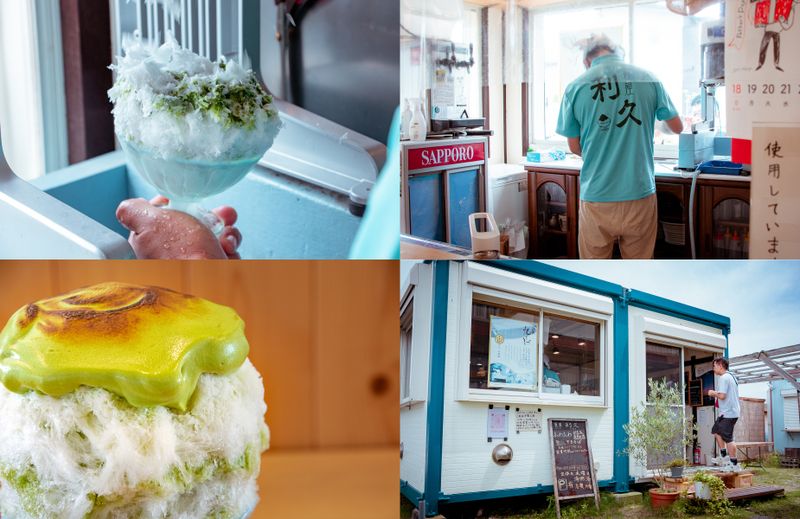
Kakigori at Natsuya Rikyu in the Shizunami Beach area of Makinohara, Shizuoka Pref.
From the Shizunami Beach area Toso Tanuma Kaido Avenue follows the coastline south to Makinohara’s other center of beach and surf culture, Sagara. En route, the cruisy avenue passes more surf shops and surf-inspired eateries.
Keep a close eye out for curry restaurant Curry fornia Hug. You’ll have no problem spotting the large sign by the road but the restaurant might prove more elusive unless you know that it’s the former soba restaurant right in front of you, still sporting much of its original signage.
Inside, a traditional soba-restaurant interior meets surf culture, spicy curry, and the love of a good pun. It might sound like an unlikely recipe but it’s a popular one. Try the house special kenken curry which comes loaded with more than 15 different spices and seasonings. Pair it with a homemade hamburger, or "hambaagu," which the owners have been perfecting for over 35 years, for an effective post-surf refuel.
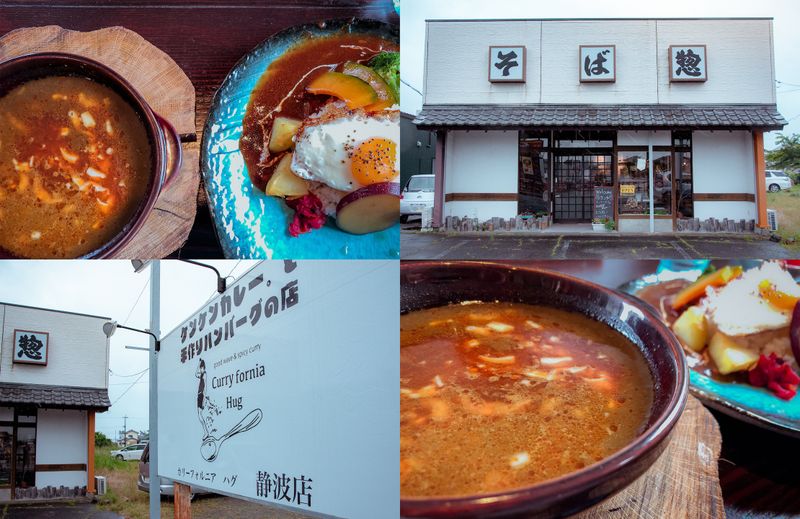
Restaurant Curry fornia Hug, along Toso Tanuma Kaido Avenue, Makinohara, Shizuoka Pref.
Roughly halfway between the two beach areas, set just off the main road, Ogane-ke is a rewarding stop for sightseeing.
The old manor house dates back to the middle of the Edo Period (1603-1868) and is the oldest existing privately constructed building in the area, once the home of a former retainer of the ruling shogun.
Inside the main house visitors can marvel at the massive wooden pillars and beams that support the structure and the original kitchen stove designed to feed the some 30 people who once resided in or ran the house. Note the low ceiling, designed to deter the drawing of swords, according to a member of staff.
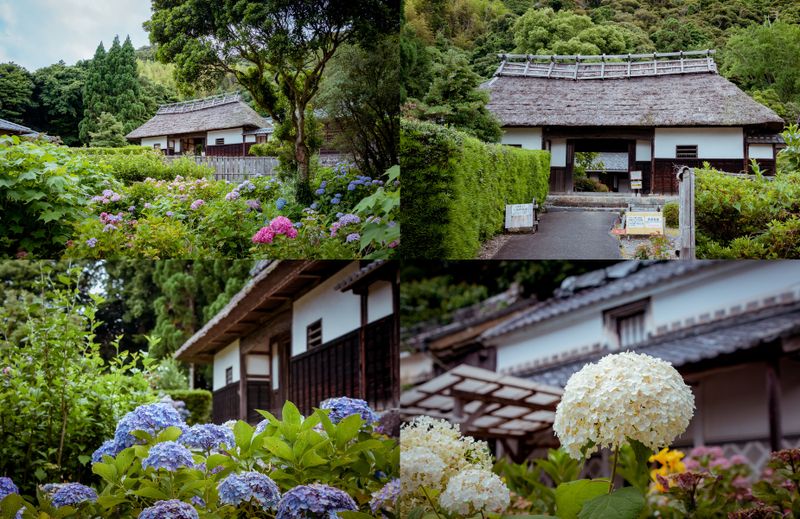
House and gardens of Ogane-ke, Makinohara, Shizuoka Pref.
Ogane-ke is perhaps best known for its gardens which extend from in front of the property’s impressive gate and climb up the hillside behind the main buildings. Between May and June the gardens burst into color courtesy of over 10,000 flowering hydrangeas. Between September and October it’s the turn of the cotton rose. Flowers in bloom or not, the house and gardens make for a pleasant place to explore and perhaps to cool down after time spent soaking up the sun at the beach.
Sagara’s quieter beach scene is ideal for kicking-back and reflecting on a day well spent and taking in the colors at dusk. There are opportunities for surfing and fishing here too, although visiting surfers should ask around before charging into the line up.
The area is home to a number of interesting accommodation options and is a good place to stay in Makinohara to sample an easy-going, local atmosphere. Many accommodations are within walking distance of the coast.
After a morning spent enjoying Sagara’s beaches, opportunity for exploration awaits north of Hagima River around Heidenji, a Zen Buddhist temple where people come to practice zazen meditation.
Heidenji dates back to 1283. The temple has been victim to seven fires, according to a local priest. The main hall, or "hondo," in its current guise was constructed under the orders of Tanuma Okitsugu, lord of the Sagara domain, in the mid-to-late 18th century. Heidenji has a close association with the Tanuma family whose family temple, Shorinji, is located in Tokyo’s Komagome district.
A special entrance toward the left of the hall at Heidenji remains in place. The entrance was built for the exclusive use of the Tanuma family and once led to a private place of worship.
The quiet beauty of the temple grounds might come as an unexpected surprise after all the surf-inspired iconography that decorates the coastline. The well-kept grounds include a bell tower and pond.
If you’ve got the legs, it’s possible to walk from Heidenji to Namikirifudo, a small temple to the southeast, managed by the priests at Heidenji. A stiff climb up to the temple rewards with views to the ocean. Local people sought refuge here following one of the large Ansei earthquakes in the mid-19th century and the temple is popular as a place of worship for local fishermen.
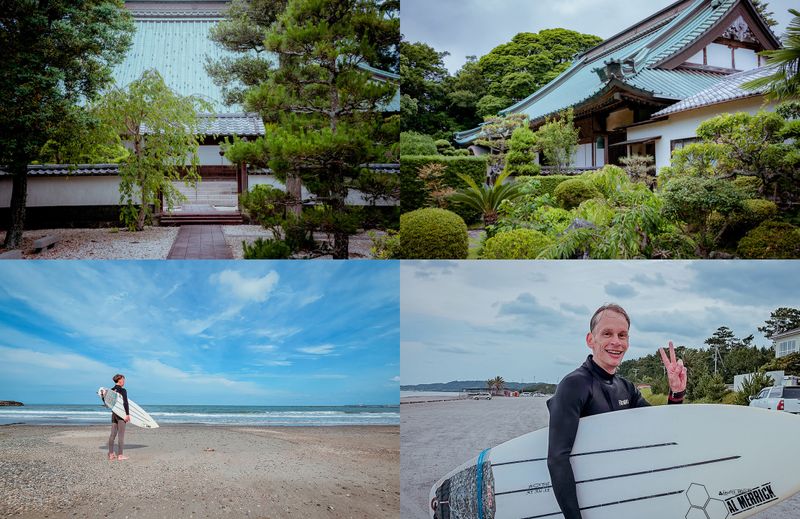
Heidenji temple and Sagara Beach scene, Makinohara, Shizuoka Pref.
Positioned between mountains and sea there are two things in Makinohara that really vie for the visitor’s attention - surfing and tea. It’s an unlikely pairing perhaps, but both are taken seriously in these parts - city officials even hand out business cards featuring a mascot surfing on a tea leaf, "chaafin."
In fact, any visit to Shizuoka Prefecture will almost certainly offer the chance to experience tea in some way, even if it’s just taking in the striking view of rows of tea plants clinging to the mountainsides seen from the highway. Shizuoka is Japan’s largest tea producer, responsible for serving-up around 40 percent of the nation’s favorite beverage.
Makinonara’s mountains rise to meet the Makinohara Plateau, a vast area carpeted with tea fields which collectively form the largest tea plantation in Japan, responsible for around 40 percent of Shizuoka’s production.
Despite its impressive scale and output, tea production on the plateau is a relatively new undertaking having begun with the samurai guards of Japan’s final ruling shogun, Tokugawa Yoshinobu, who retired to present-day Shizuoka City following the country’s transition to imperial rule during the Meiji Restoration. Yoshinobu’s guards followed him to the region, swapping their swords for farming implements to begin tea cultivation on the plateau. The first tea leaves were picked here in 1873.
The cooler temperatures at higher altitude and the refreshing greens of the plateau might be the perfect antidote for those visitors with limbs sore from surfing and sun-soaked, salty skin.
An introduction to tea production in the area can be found at Grinpia Makinohara, a kind of tea "theme park" offering factory tours as well as tea-picking experiences in accordance with the four picking seasons.
Tea produced at Grinpia can be tasted and purchased at the onsite store. Try the popular Asahinahara, a kind of fukamushi-cha, or "deep-steamed green tea," for which the plateau is famous. Visitors can also challenge their palate at the store with the seven grades of matcha gelato from Nanaya, a brand produced by tea wholesaler Marushichi Seicha. Some visitors might want to ease their way into the Premium No. 7, labeled as the world’s strongest matcha gelato.

Tea picking experience and the world’s strongest matcha gelato at Grinpia Makinohara, Makinohara, Shizuoka Pref.
The remarkable sight of the Makinohara Plateau, stretching across some 28km from Shimada in the north to Omaezaki in the south, might invite some visitors to try feverishly to capture the spectacle in a photograph. In others the vast scale might invite them to take pause and reflect. Either way, it is without doubt a fine place to end a stay in the region.
The heights of the plateau also connect Makinohara to the rest of Japan, with highways whisking some travelers east toward Tokyo, others west toward Nagoya. Mt. Fuji Shizuoka Airport is also nearby.
Plenty of travelers though, will likely be wishing they could make a u-turn and head back down to the coast to seek out more waves and further improve their balance, on the surfboard and in life.
Stay
Both the Shizunami and Sagara beach areas of Makinohara offer surf and beach-inspired accommodation options. The Sagara area might offer more quiet.
Cafe & Dining Tanuma - Sagara district
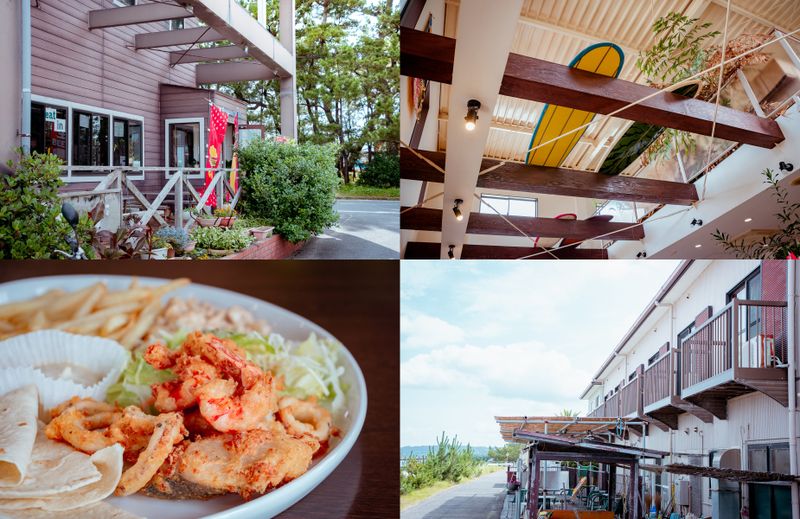
This minshuku-style facility is perfect for those surfers and beach lovers who struggle to tear themselves away from the sand - the simple tatami rooms at Cafe & Dining Tanuma open onto small balconies overlooking Sagara Sun Beach. (Any closer and you’d have your toes in the sand.) Rooms have their own toilet and sink. Reward tired muscles with a long soak in one of the large, hot communal baths (female on the first floor, male on the second floor at the time of writing).
Tanuma’s airy cafe is decorated with memorabilia and surfboards belonging to owner and well-traveled surfer Katsuhiko Nishitani. Nishitani and his family cook-up hearty dishes inspired by culinary encounters and the necessity to refuel during years spent globe-trotting and searching for waves - loco moco, jerk chicken, spam and tortilla dishes are all on the menu.
Nishitani can also advise guests on where to surf, fish, and generally how to make the best of their time by the ocean while in Makinohara.
Even though conditions were far from great, we managed to catch a few waves off the stretch of beach immediately in front of the accommodation.
HAZ Cottage - Hazu district

Hidden off the quiet, hilly streets of the Hazu district southwest of Sagara Sun Beach, this cottage and campsite is an absolute treat for those traveling in a small group. A single group can choose between a cozy airstream trailer or a spacious cottage, beautifully renovated from a Japanese-style house.
HAZ Cottage is run by a husband and wife team who have created a cottage interior that manages to be bright and spacious yet warm and cozy, and is decorated, furnished, and fitted with carefully selected antiques, items from overseas (Moroccan drums as coffee tables), and surf-inspired art, among other wonderful pieces.
A fully-functioning counter kitchen (with espresso machine), dining area, large bath with private garden view, and "workation" desks are all accounted for. The cottage can accommodate up to 10 guests, including two single beds in a loft space and two semi-doubles in the main bedroom.
We enjoyed a BBQ on the cozy and private cottage terrace. Equipment is available to rent and guests can order a selection of local meats, including Shizuoka’s own Enshu Yumesaki-gyu beef at the time of visiting, to throw on the grill.
The site also includes a beer stand (open on weekends) serving craft brews, a large outdoor screen for movie projections, and a half-pipe skate ramp (sometimes the venue for local contents), among other features.
Treat yourself to one of two delightfully rustic onsite saunas which the owners will heat-up in preparation for use in the evening.
From HAZ Cottage it’s about a 15-minute walk to the beach.
Information
Shizunami Surf Stadium: https://www.surfstadium-japan.co.jp/
This article is supported by Makinohara City: https://www.city.makinohara.shizuoka.jp/



0 Comments